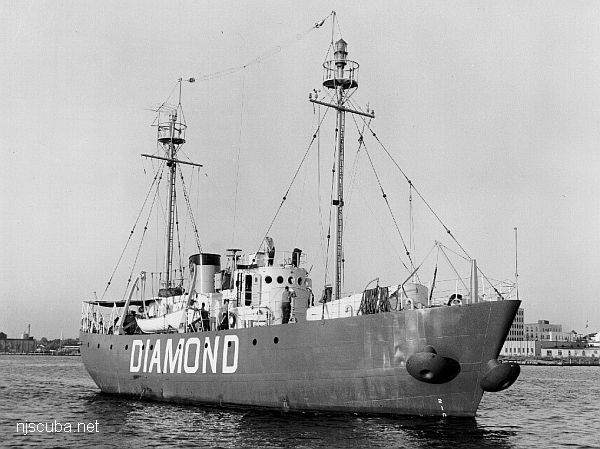Artificial Reefs Overview
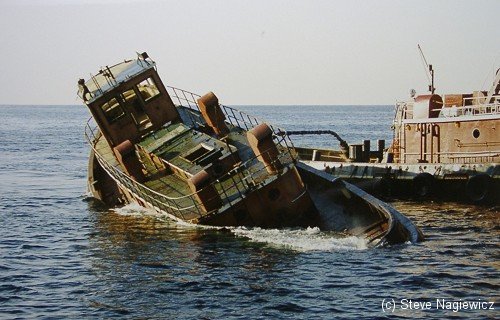
Objectives of the Reef Program
New Jersey's Reef Program is administered by the Department of Environmental Protection's Division of Fish and Wildlife. The objectives of the program are to construct hard-substrate "reef" habitat in the ocean for certain species of fish and shellfish, new fishing grounds for anglers, and underwater structures for scuba divers.
In constructing and managing reefs, the goal is to spread the benefits of reef resources to as many people as possible. The intent of the program is not to change New Jersey's marine environment, but rather to enhance a small portion, less than 1 percent of the seafloor, to benefit 150 species of marine life that prefer structured habitat.
Benefits Derived From Artificial Reefs
- Marine Life Production and Biodiversity
Reefs add a hard-substrate habitat to NJ's sandy sea floor. Studies show that reef habitats are colonized by 200 species of fish and other marine life. Reef structures may have 800 to 1000 times more biomass (weight) of marine organisms than an equal area of sea floor. - Seafood
Both recreational and commercial fisherman harvest millions of pounds of fish, lobsters, crabs and mussels from NJ reefs each year. - Fishing
Reefs are becoming extremely popular with recreational fisherman. Anglers caught 4.8 million fish on NJ reefs in 2000. - Diving
Artificial reefs accounted for about 36 percent of scuba diving activities in NJ's ocean waters in 2000. - Sportfish Industries
Without counting the costs of boats, recreational fishermen and divers spent about $15 million in 2000 to enjoy fishing and diving on NJ reefs. - Improved Water Quality
Many of the animals, such as blue mussels, barnacles and sponges, which live in large numbers on reef structures, filter algae, organic matter and bacteria from the water column, thus improving both the cleanliness and clarity of NJ's ocean waters.
How Reef Structures Benefit Marine Life
Surface Area
In the ocean, the surface area of a habitat is very important because it represents the interface between the surface upon which an animal lives and its exposure to the water column where it feeds and respires. The sandy seafloor is two-dimensional and has a relative surface area of 1. Three-dimensional reef structures, on the other hand, have height and thus more living area for the same relative unit of seafloor that they occupy.

A human analogy would be a comparison between the floor space of a ranch house and that of a high-rise apartment building, both occupying the same footprint on the ground. The taller and more complicated a structure, the more surface area is available for marine life to colonize and consequently, the more productive it can be.
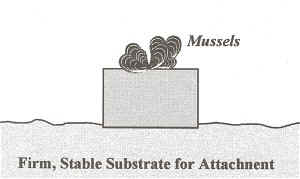
Firm, Stable Substrate
Unlike sand that is constantly shifting, reef structures provide firm, stable substrates for the attachment of marine life. Once anchored in place on a reef structure, marine life can withstand strong ocean currents and storms.
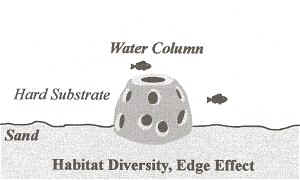
Habitat Diversity
Reef structures add a third component to New Jersey's marine environment, which now consists of sandy seafloor and water column habitats. The more diverse an environment, the more options are available to marine life and thus, the greater the diversity of species living there.
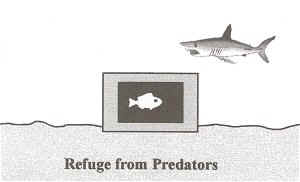
Refuge
The nooks and crevices of reef structures provide hiding places for juvenile and adult fish and other marine life to avoid predation.
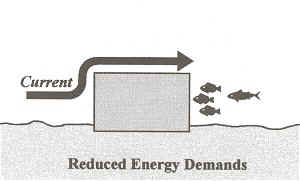
Reduced Energy
The diffusion of currents by reef structures provides calm water, resting areas for fish, much like a boulder provides relief for a trout in a stream. Thus, the energy that would otherwise have been wasted upon swimming against the current can be better put towards growth.
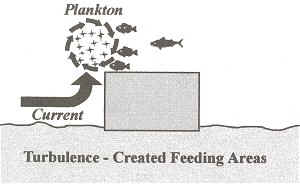
Turbulence
The deflection of currents by reef structures can result in the creation of eddies that concentrate plankton, a prime food source for young fish. Schools of planktivorous fish often concentrate in these feeding zones.
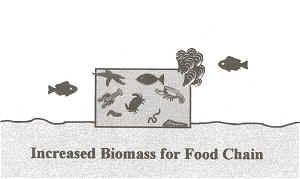
Increased Biomass
The increased biomass ( weight of marine life ) associated with reef structures provides a ready source of food for fish and other marine life.
Study Reveals Reefs Enhance New Jersey's Marine Environment
By Bill Figley, Principal Fisheries Biologist
Results from a recent reef colonization study conducted from 1996 to the present by the Division of Fish and Wildlife indicate that New Jersey reefs support hundreds of times more marine life than the sandy seafloor. The study wa5 conducted to determine the types and amounts of marine life that colonize ocean reefs and to compare those levels with what is normally found on the sandy bottom, It was an attempt to answer the question: Do reefs produce marine life or simply attract it?

The study began in 1996 when 30 experimental reef habitats were placed on the Barnegat Light Reef Site. Each habitat consisted of a 3' x 1' x 1' plastic-coated wire box embedded in a concrete base. The boxes were filled with a variety of materials to imitate the hiding places found on reefs and to duplicate common reef-building materials. Each box contained 10 corrugated fiberglass panels, 50 whelk shells ( large snails ), and eight plates of four common, reef-building materials: steel, concrete, rock, and tire rubber.
Over the past five years, scuba divers retrieved a total of 10 habitats from the ocean reef site. The divers encapsulated each habitat in a plastic drum to capture all of the marine life inside. After each year's collection, Fish and Wildlife biologists spent four months in the lab removing, sorting, counting, identifying, and weighing the marine life living within the experimental habitats. What they found was impressive. Over 145 species of marine life, including fish, crabs, shrimp, lobster, mussels, barnacles, starfish, urchins, snails, worms, sponges, anemones - and many more - had colonized the small, experimental habitats.
Biologists estimate that a one-square meter area of reef habitat is home to 432,022 individual marine organisms. In an area the size of a card table, the reef provided homes for 118,651 mussels, 29,310 barnacles, 4,626 anemones, 16,626 worms, 2,349 urchins, 3,545 crabs, 22 lobster, and 133 young fish less than four inches long. In addition, the habitat also was colonized by colonial encrusting organisms such as stone coral, bryozoans, hydroids, and sponges, that could not be enumerated, but collectively accounted for hundreds of thousands of organisms. These experimental habitats have the population of a city in a microcosm. The total biomass of all these organisms amounted to 129 pounds. Biomass is a biologist's measure of the weight of all the organisms living in a particular habitat. In this study, biomass referred to the weight of all marine life inhabiting a square meter of seafloor.
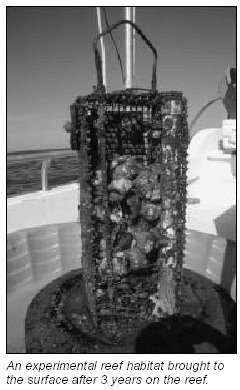
The Division also collected 60, one-foot-square samples of the sandy seafloor near the Cape May Reef. A similar area ( square meter ) of sandy seafloor naturally has only about 2.5 ounces of marine life. Thus, on an equal area basis, reef habitats have 825 times more biomass than the sandy bottom. Reef structures are three-dimensional and thus, offer more attachment surfaces for marine life growth than the two-dimensional seafloor. Also, the firm substrate of a reef structure enables encrusting organisms to withstand storms which stir up the sand bottom. The numerous crevices and holes of a reef offer fish, crabs, and other mobile animals secure places to hide from predators.
The increased biomass of the reef habitat is significant because it represents a far greater food source for ocean predators. The study revealed that marine life populations on the habitats which were exposed to predation. were reduced by over 45 percent due to feeding by fish, crabs, lobster, and starfish. The investigation also demonstrated that there were no significant differences in the colonization of various reef materials: concrete, steel, rock, and tire rubber. Apparently, mussels, barnacles, and other encrusting organisms are not discriminating, they just require something firm upon which to attach. Manmade materials ( concrete, steel, rubber ) are just as productive as natural rock.
New Jersey reefs are colonized entirely by marine animals. The depths on reef sites, generally over 60 feet, are too great for the penetration of sufficient light to sustain plant growth. Instead of plants, the foundation of the reef food web consists of many species of filter-feeding animals that live attached to reef structures and feed by straining the plankton carried past them by ocean currents. Filter feeders ( i.e. mussels, barnacles, tubeworms, and others ) are in turn eaten by fish, crabs, and lobsters. Stationary filter feeders serve another function on the reef by providing a carpet of cover or hiding place for small mobile invertebrates such as shrimp, snails, and worms. These animals also may become food for larger predators that comprise this trophic web.
The goal of building reefs, which provide a firm, stable substrate for the attachment of marine organisms, is to enhance the biological productivity of the seafloor. Based on the results of this study, reefs do enhance New Jersey's marine environment. By providing new homes for fish and shellfish, reefs also create new fishing grounds for anglers and interesting attractions for scuba divers.

